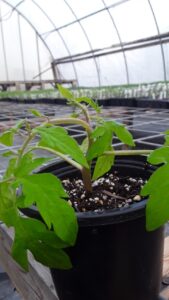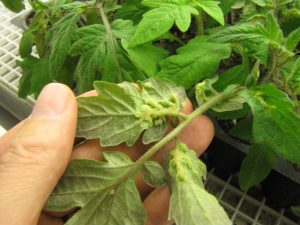Tomatoes grown in a controlled environment are exposed to different conditions from their original habitats. As a result, some plants may respond to the controlled environment with abnormal symptoms.
Leaf and stem curling and distortion are symptoms we may see in the early season in greenhouses (Figure 1). This symptom might be caused by ethylene damage, an air pollutant caused by a malfunctioning heater. You can find more information about this problem in this article March 16,2022 Issue #700

Figure 1. Leaf and stem curling symptom on tomato seedlings can be caused by ethylene damage or a combination of low light and high relative humidity caused edema.
Ethylene is not the only factor that may cause tomato leaf and stem curling symptoms. Low light and high humidity can also cause similar symptoms, known as edema (oedema). In this case, bumps, galls or blisters may develop on leaves, petioles or stems (Figure 2). While ethylene seems to affect all varieties, varieties vary greatly in their susceptibility to edema. I have observed the most severe symptom on tomato rootstocks bred from wild tomatoes.
Recently, I received photos of tomato seedlings that had leaf and stem curling symptoms. The farmer told me that his first response was to ask professionals to check the heater, but he was told the heater was functioning properly. We then discussed light. The farmer shared that the greenhouse plastic is seven years old. He was planning to change it last fall but could not do it. Apparently, the recent cloudy, rainy, and cool days did not help the situation.
Different from a disease problem where specialists can find the pathogen and be able to ID the disease. It is not easy to confirm a problem caused by environmental factors. However, the above discussion does make me think low light might be the cause of the problem. It is known that low light, especially low UV light can cause tomato edema.
I suggested moving the plants out of the greenhouse. Ideally, exposing them to full sunlight for a few days. It looks like the coming warm and sunny weekend may provide an opportunity. If plants continue growing in a low light condition, cut down irrigation and increase air movement to reduce relative humidity. I hope this practice can help lessen the symptoms.
Another piece of advice, not delay changing greenhouse or high tunnel plastic. The life expectancy of greenhouse polyethylene cover is typically 3-4 years. After that, light transmission can decrease significantly, causing problems, especially under extended cloudy days. This article (July 19, 2018 Issue#647) provides a case study about light levels under an old vs. new plastic in a high tunnel.
